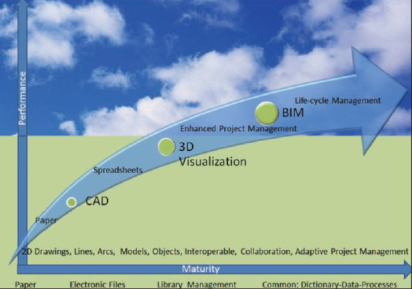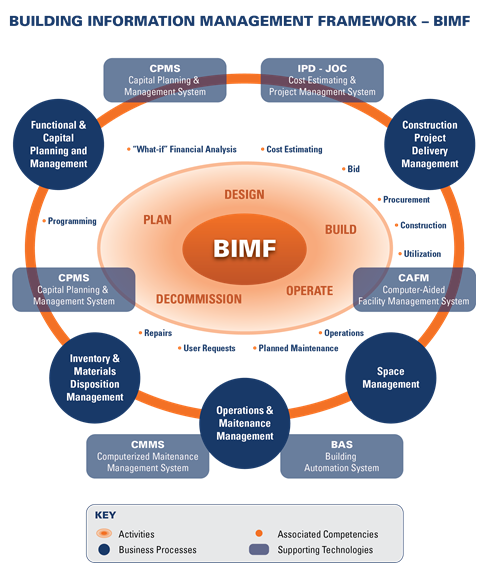BIM and the Cloud – SAME 2012 – 4Clicks Solutions LLC – PDF

BIM (Building Information Technology) and THE CLOUD (Cloud Computing) are disruptive technologies converging to significantly alter traditional construction and facility management practices.
Both technologies also embed associated business process rules and components which will enable enhanced life-cycle management of the built environment, alignment of structures with organizational mission, and better consideration of general community impacts.
The ever increasing competitive financial and environmental landscape are requiring public and private institutions to further maximize facility planning and management.
Leading organizations are already investing in the formalized definition and creation of robust business process frameworks, cultures, workflows, and capabilities to support collaboration, continuous improvement and/or LEAN practices needed to achieve higher productivity within the Architecture, Engineering, Construction, Owner and Operator (AECOO) sector.
BIM and THE CLOUD provide the digital backbone to support the cost effective, scalable development and deployment of adaptive and efficient facility life-cycle management practices.
Definition of BIM
Building Information Management (BIM) is the life-cycle management of facilities[1] supported by digital technology.
BIM can be applied at various levels. Current the most common being use of proprietary 3D visualization software for the purpose of supporting the design and construction phases of the facility life-cycle. At this level BIM’s value is primarily to Architects, Architectural Engineers and Business Development Professionals, as well as Owners working to design, market, and construct new facilities. Case studies have documented the cost and time savings offered at this level of BIM application, however, BIM’s ability to support the fully facility life-cycle – planning, design, procurement, construction, operations, repair, renovation, sustainability, adaptation, and
deconstruction – is where the highest value of BIM will be achieved. Attainment of this advanced life-cycle implementation of BIM on a widespread basis however the will require the following to occur:
1. Major cultural change within the AECOO sector,
2. Standardized taxonomies and data architectures, and
3. The availability and integration of secure technology to promote collaboration and
the Integration of currently disparate business processes and knowledge domain specific software applications such as; Capital Planning and Management Systems (CPMS), Computer-Aided Facility Management (CAFM), Cost Estimating and Project Management, Efficient Construction Delivery Methods (IPD-Integrated Project Delivery, JOC-Job Order Contraction), Computerized Maintenance Management Systems (CMMS), Geographic Information Systems (GIS), and Building Automation Systems (BAS). A view of how these components pertain to an overall BIM strategy and facility life-cycle is represented in Figure #1.
BIM holds many of the keys to restructuring and dramatically improving overall performance and productivity within our industry, however, cloud computing is equally important.
Definition of THE CLOUD
Cloud computing and/or cloud technology (THE CLOUD) is “a model for enabling convenient, on-demand network access to a shared pool of configurable computing resources (networks, servers, storage, applications, and services) that can be rapidly provisioned and released with minimal management effort or service provider interaction.”[2]
THE CLOUD allows users to access parts of virtually limitless application and computing resources on-demand. Access is faster and easier than traditional “client-server” or “web-based” applications. While some software vendors may host their legacy applications on the cloud, and call them “cloud apps”, a practice known as “cloud-washing”, true cloud applications offer all of the following elements:
• On-demand self-service: a user to can sign up and receive services without delay.
• Broad network access: ability to access the service via multiple platforms; desktop,
laptop, mobile/handheld.
• Rapid elasticity/scalability: computing resources are available to meet requisite
demand.
• Measured Service: Metered and/or time based billing based upon computing resource
levels and/or storage levels vs. time.
There are several levels of cloud computing, which may appear distinct and tend to blend and even become transparent based upon the type of usage:
– Software as a Service (Saas): SaaS is the “end-user” level of cloud computing. Access to software application, such as Microsoft Excel for example, is provided on an on-demand basis via a web browser. Applications are available via the Internet on a “right to use” and “pay-as-you-go” subscription model. There is no additional annual fee for software maintenance, or any need to worry about upgrades or patches, etc. Users simply pay a monthly or annual fee for access and use based upon time and/or usage.
– Platform as a Service (PaaS): PaaS is the set of tools and services designed to make coding and deploying SaaS applications efficient. While transparent to most end-users, it is the power to create and deploy applications exponentially faster within a standardized, secure environment that is driving the adoption of THE CLOUD.
– Infrastructure as a Service (IaaS): IaaS represents all the associated hardware and software infrastructure – servers, storage, networks, and operating systems.
BIM and CLOUD Convergence
To better understand the explosive power of mixing BIM and CLOUD relative to removal of the traditional process and technology silos within the AECOO sector that have held back productivity improvement for decades, it’s important to look at cloud computing in a bit more detail.
SaaS is tailor made for applications where there is significant interplay between the user organization and the outside world. Applications that have a significant need for web or mobile access. Software where usage may be intermittent, and or demand spike occurs frequents.
All of these are common within all phases of construction, repair, renovation, or sustainability projects.
PaaS, platform as a service, also offers several key capabilities. Tools and services to test, deploy, host, and maintain applications are provided within one integrated development environment. Brower and/or web graphical user interface (GUIs) creation tools are also a part of PaaS platforms to speed the ability to create, modify, test and deploy client-specific applications.
All of the above is accomplished within a “multi-tenant architecture” within which concurrent developers work within the application.
This translates into the ability to build and deploy massively scalable, secure applications at a fraction of the time it would have taken for traditional software deployments.
Additionally, this is all accomplished within a set of common standards, assuring the ability to “talk” to virtually any other application. Multiple developers can be working on a development project and/or other external parties can easily become part of development process. This ability is critical where multiple professionals have existing data sources – cost data bases, project information, contract information, etc. and need to enhance the ability to pull and maintain knowledge from these sources. A notable example of a PaaS platform is Microsoft AzureTM.
From a facility life-cycle perspective, imagine the following within a BIM environment.
Again, please keep in mind that BIM is not “just” 3D model-centric visualization or rendering of building information, but rather collaborative access and ongoing use of a wide range of building information throughout its life-cycle: cost data, physical or functional conditions, utilization, life/safety, sustainability, etc.
Cloud computing allows facility stakeholders throughout the world to work concurrently upon the same data. For example, let’s us take the creation of cost estimate for a major facility renovation. The renovation is located in a foreign country, however, part of a large real property portfolio owned and managed by an Owner based in the United States.
Anyone that is proposed to participate or participates in the project and simple by invited by the Owner, and or the Owner’s representative. The invite is sent directly from the SaaS cost estimating and project estimating program, and/or adaptive construction project delivery / adaptive construction management system (ACMTM, APDTM, ). The invites can be sent in any language automatically. Invites allow access to information to a specified level of granularity and/or to a domain Once invited, and upon acceptance and confirmation, the invitee will see only the subset of information enabled by the “host”. Perhaps the Owner is providing full access to a general contractor, or the general contractor may be providing limited access to a sub-contractor. Invited parted may be allowed to conduct work on the information, such as prepare a construction cost estimate, and/or work jointly upon an existing cost estimate.
Regardless, changes can be made at any time, and at any level, as defined by the account administrator. Each change can be done in locate language, currency, etc. Each change is automatically recorded and tracked right down to time and user, with full “undo” and “redo” capability. This is real-time collaboration and transparency. This is BIM.
The above only begins to relate the enablement provided by the BIM/CLOUD convergence.
All aspects of a BIM strategy or BIM framework, as portrayed in the Figure #1, can be cost effectively implemented and supported by a digital BIM/CLOUD framework.
As the technology solution provided by cloud computing enters the AECOO sector, standardized life-cycle process definitions and associated exchanges of information take front stage to insure that various domain-specific meanings are consistent and apparent at all levels of granularity.
Robust, proven business process, such as efficient project delivery methods such as IPD-Integrated Project Delivery and JOC-Job Order Contract[3] will be easily and cost-effectively implemented and consistently deployed throughout organizations regardless of type or location.
Owners, AEs. Contractors, and Subcontractors will be empowered to access and use these and other methods to significantly improve collaboration and productivity. Furthermore, changes can readily be made to both processes and technology to adapt to specific localized requirements and/or to keep paces with dynamic conditions.
That fact that business process and workflows of these efficient project delivery methods, and all other components of a BIM Framework, are embedded into the cloud technology is central to the empowerment and success of all built environment stakeholders. Using traditional technology and methods, these capabilities would be limited to organizations that could afford the associated “front end” implementation and ongoing technology and process management costs. And even then, success would not be assured as collaborative and “real-time” monitoring, as well as adaptive response are not readily available.
Conclusion
Cloud computing technology enables the rapid development, deployment, and ongoing adaptation of proven, robust BIM processes. It is the consistent, collaborative creation and ongoing use of facility life-cycle information for both new and existing buildings, spanning design, procurement, construction, renovation, repair, adaptation, and deconstruction that defines BIM. Cloud technology is the framework upon which BIM processes will be created, deployed and maintained.
BIM and Cloud Computing together will significantly expand the ability of all stakeholders to more efficiently better the built environment on a widespread basis.
Once sequestered in silos – Owners, Real Property Managers, Facility Managers, Architects, Engineers, Contractors, Sub-contractors, Operations and Maintenance, Financiers, Safety and Security, Business Product Manufacturers, and Oversight Groups – will now have the ability to base their decisions upon transparent, common information.
[1] The terms “facility” or “facilities” are used to define vertical (buildings) and horizontal (bridges, roadways, utilities…) built structures.
[2] National Institute of Standards and Technology (NIST)
[3] Job Order Contracting (JOC) is an form of Integrated Project Delivery for facility renovation, repair, and sustainability construction projects. Both IPD and JOC are decades old and proven to be effective at improving productivity and mitigating both change orders and litigation.



